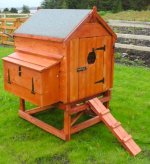Is anyone else struggling with the war against red-mites this year, or is it just me? I'm treating every 5 days but I'm getting nowhere. They were under control but now they're on the rampage! :x
I'm currently using 'Red-Mite Concentrate' (at the correct concentration!) It's made by Barier Health Care. It's more expensive than 'Total Mite Kill' but can also be used on the birds themselves, & when the mites are under control, maintenance treatments are supposedly every 6 weeks So I decided to pull out the stops & go for it. Now I'm wondering if I've been had!
So I decided to pull out the stops & go for it. Now I'm wondering if I've been had!
Is it this warm wet weather that's making the numbers sooooooooooo high? It's not just red mites, but 'normal' mites as well...I'm at my wits end!
Our grass is also quite long because we can't get it cut due to all the rain, is that also a contributing factor? All I can think of!
All help & advice very gratefully received!
I'm currently using 'Red-Mite Concentrate' (at the correct concentration!) It's made by Barier Health Care. It's more expensive than 'Total Mite Kill' but can also be used on the birds themselves, & when the mites are under control, maintenance treatments are supposedly every 6 weeks
Is it this warm wet weather that's making the numbers sooooooooooo high? It's not just red mites, but 'normal' mites as well...I'm at my wits end!
Our grass is also quite long because we can't get it cut due to all the rain, is that also a contributing factor? All I can think of!
All help & advice very gratefully received!


